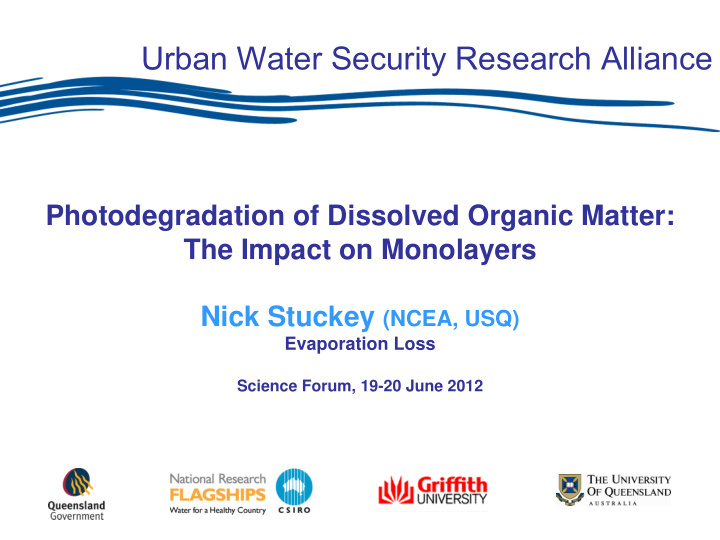



Urban Water Security Research Alliance Photodegradation of Dissolved Organic Matter: The Impact on Monolayers Nick Stuckey (NCEA, USQ) Evaporation Loss Science Forum, 19-20 June 2012
Varying Field Performance of Monolayers • Monolayers reduce evaporation by ≤ 60% • Some field trials 0% reduction • Field results extreme day to day variability (10-40%)
Factors Affecting Field Performance of Monolayers • Mechanical disruption of monolayer film – Wind – Waves – Beaching – Introduction of impurities • Volatilization • Dissolution into subsurface • Microbial degradation • Photodegradation – Direct – Indirect
Impact of the Microlayer on Monolayers? High conc. DOM (100 to 500 m thick) Norkrans 1980 Advances in Microbial Ecol 4 pp51-85
Photodegradation of Monolayers • Monolayer compounds may undergo photochemical reaction – Direct photolysis = chemical change due to photon absorption by chromophores in molecule – Indirect photolysis = reaction initiated by chromophore light absorption in other molecules
Structure of Monolayer Compounds Studied H 3 C OH Hexadecanol – (C 16 OH) C 16 H 34 O H 3 C OH Octadecanol – (C 18 OH) C 18 H 38 O OH H 3 C O 2-octadecoxyethanol – (C 18 E 1 ) C 20 H 42 O 2
Direct Photodegradation of Monolayers • Monolayer applied to distilled water • Volatilization = samples placed in the dark • Direct photodegradation = samples irradiated • Monolayer loss measured as reduction in evaporative saving Volatilization Direct Photodegradation Hexadecanol (C 16 OH) 22.8% 23% Octadecanol (C 18 OH) 18.6% 18.8% 2-Octadecoxyethanol (C 18 E 1 ) 14.2% 14.3%
Water Bodies Monitored for this Study a b c f d e g h a - Kearneys Spring, b - Lake Annand, c - Caffey Dam, d - Lake Apex, e – Logan’s Dam, f – Lake Dyer, g - Narda Lagoon, h - Pittaway Pond
Water Bodies Selected for this Study Kearneys Lake Caffey Lake Logan’s Lake Narda Pittaway Spring Annand Dam Apex Dam Dyer Lagoon Pond Brown Water Black Turbid Brown Water Clear Water Water
Indirect Photodegradation of Monolayers • Monolayers DO NOT undergo direct photodegradation • Reactive species in water degrade monolayers – e.g. LMWC 1 O 2 , 3 O 2 , ·OH • DOM photochemical reactions produce reactive species • Photodegradation of monolayers IS INDIRECT
Photoreactivity of Water Bodies • > > photoreactive DOM produces > > reactive species • > > reactive species produce higher rates of photodegradation of monolayers • DOM quality and quantity varies within water bodies
Photoreactivity of Water Bodies • Indirect photolysis > > in more reactive water bodies • Pesticide degradation = index of indirect photolysis (natural cleansing) • Pentachlorophenol for my study • << half-life > > photoreactive the water body
Photoreactivity of Water Bodies – PCP Half-lives
Photochemical Properties of DOM • Several tests investigated – DOC – UV Absorbance (253.7 nm) – Aromaticity (UV Abs 280 nm) – Permanganate Index – Molecular Size (E 2 /E 3 Ratio) – IR spectroscopy • Relationship with photoreactivity?
Relationship with Photodegradation
Grouping of Permanganate Index Results
Photoreactivity of Water Bodies Group 1 Group 2 Group 3 High Reactivity Moderate Reactivity Low Reactivity KMn ≤ 3.37 3.37 ≥ KMn ≤ 4.46 KMn ≥ 4.46 (Apex, Narda, Pittaway) (Annand, Logans) Kearney, Caffey, Dyer
Monolayer Half-lives – Wet Season
Monolayer Half-lives – Dry Season
Seasonality of Photoreactivity
Monolayer Performance Specifications • C 16 OH not suitable, volatilization too great • C 18 OH – suitable for clear and coloured water (Annand, Apex, Logan’s, Narda, Pittaway) • C 18 E 1 – restricted for use on clear water only (Kearney, Caffey, Dyer) • Monolayer selection may change with season
Urban Water Security Research Alliance THANK YOU www.urbanwateralliance.org.au
Recommend
More recommend